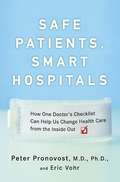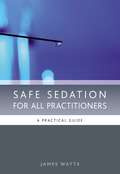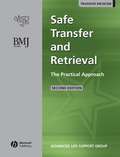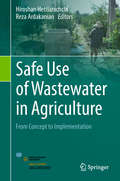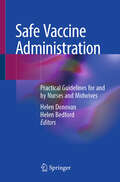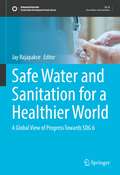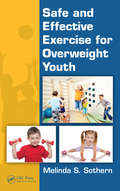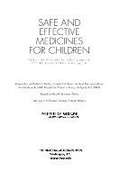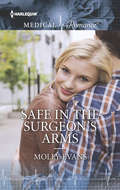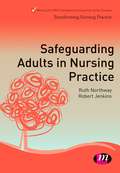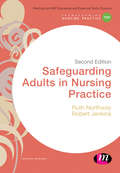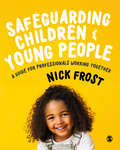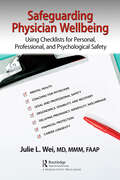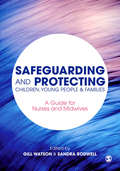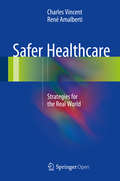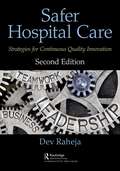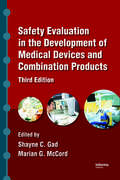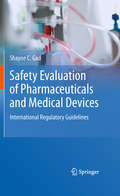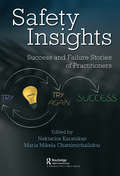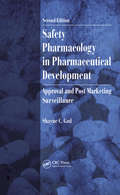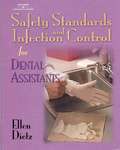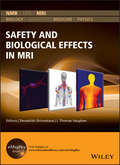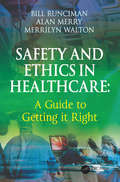- Table View
- List View
Safe Patients, Smart Hospitals: How One Doctor's Checklist Can Help Us Change Health Care from the Inside Out
by Peter Pronovost Eric VohrThe inspiring story of how a leading innovator in patient safety found a simple way to save countless lives. First, do no harm--doctors, nurses and clinicians swear by this code of conduct. Yet in hospitals and doctors' offices across the country, errors are made every single day--avoidable, simple mistakes that often cost lives. Inspired by two medical mistakes that not only ended in unnecessary deaths but hit close to home, Dr. Peter Pronovost made it his personal mission to improve patient safety and make preventable deaths a thing of the past, one hospital at a time. Dr. Pronovost began with simple improvements to a common procedure in the ER and ICU units at Johns Hopkins Hospital. Creating an easy five-step checklist based on the most up-to-date research for his fellow doctors and nurses to follow, he hoped that streamlining the procedure itself could slow the rate of infections patients often died from. But what Dr. Pronovost discovered was that doctors and nurses needed more than a checklist: the day-to-day environment needed to be more patient-driven and staff needed to see scientific results in order to know their efforts were a success. After those changes took effect, the units Dr. Pronovost worked with decreased their rate of infection by 70%. Today, all fifty states are implementing Dr. Pronovost's programs, which have the potential to save more lives than any other medical innovation in the past twenty-five years. But his ideas are just the beginning of the changes being made by doctors and nurses across the country making huge leaps to improve patient care. In Safe Patients, Smart Hospitals, Dr. Pronovost shares his own experience, anecdotal stories from his colleagues at Johns Hopkins and other hospitals that have made his approach their own, alongside comprehensive research-showing readers how small changes make a huge difference in patient care. Inspiring and thought provoking, this compelling book shows how one person with a cause really can make a huge difference in our lives.
Safe Sedation for All Practitioners: A Practical Guide
by James Watts Pascale MooreSedation is a vital tool for allowing investigations and procedures to be performed without full anaesthesia, but demand for sedation greatly outstrips the supply of trained anaesthetists. Sedation requires care if it is to be used correctly and modern seditionists, including junior doctors in all specialities, medical students, anaesthetists, dentists, and theatre, dental and paediatric nurses, must be able to demonstrate they can practice safely. They need a sound understanding of the basic sciences involved, and an intimate knowledge of the required standards of practice. This book is a first-line educational resource for all those training in the techniques of sedation, and for those already practising who wish to consolidate their knowledge in a structured way.This highly practical handbook is therefore ideal for experienced and novice practitioners alike. It covers basic principles including patient selection and assessment, pharmacology, resuscitation competencies, monitoring equipment and legal issues, and the numerous clinical scenarios bring pertinent issues to life, emphasising the importance of safe practice. It is a unique universal introduction for practitioners from any clinical background.
Safe Transfer and Retrieval (STaR) of Patients: The Practical Approach
by Advanced Life Support Group (ALSG)The safe transfer of all hospital patients, especially those who are critically ill, is of crucial importance, demanding organisational, as well as clinical skills. Safe Transfer and Retrieval of Patients (STaR) is aimed at all health care workers involved with inter and intra-hospital transfers. It provides a much needed structured approach to transfer medicine, together with sound guidance on relevant clinical procedures. The second edition has been extensively revised in line with new developments in transfer medicine. The book has been redesigned with five distinct sections covering: the principles of the STaR structured approach to transfers the management of the transfer or retrieval practical procedures related to transfer medicine an overview of clinical care during the assessment and stabilisation phases of transfer. the legal and safety aspects of transfers, specific differences in helicopter transfers and transfers involving children A new chapter, the infectious or contaminated patient, has been added, in light of current concerns around the potential transfer of infection between patients and staff. The major revisions to this STaR coursebook bring it into line with the latest thinking on patient transfers, making it an invaluable guide for anyone involved in this aspect of health care.
Safe Use of Wastewater in Agriculture: From Concept To Implementation
by Reza Ardakanian Hiroshan HettiarachchiThis book offers a broad and global level description of the current status of wastewater use in agriculture and then brings the readers to various places in the MENA Region and Europe to explain how some countries and regions have addressed the challenges during implementation. On a global scale, over 20 million hectares of agricultural land are irrigated using wastewater. This is one good, and perhaps the most prominent, example of the safe use potential of wastewater. Water scarcity and the cost of energy and fertilisers are among the main factors driving millions of farmers and other entrepreneurs to make use of wastewater. In order to address the technical, institutional, and policy challenges of safe water reuse, developing countries and countries in transition need clear institutional arrangements and more skilled human resources, with a sound understanding of the opportunities and potential risks of wastewater use. Stakeholders in wastewater irrigation who need to implement from scratch or improve current conditions, find it difficult to gather the necessary information on practical implementation aspects. The main objective of this book is to bridge that gap.
Safe Vaccine Administration: Practical Guidelines for and by Nurses and Midwives
by Helen Donovan Helen BedfordThis book equips nurses and midwives with a role in providing vaccination services in the UK with the information they need to practice safely and effectively. This includes ensuring they are equipped to answer questions as they arise. Starting with the importance of vaccination for public health, the book takes a vaccination through the life course approach from pregnancy, babies and childhood, teenagers, adults to older people discussing some of the key challenges and issues with the different vaccine programmes.The book provides readers with the best practice guidance to offer a safe effective and quality service. To maximise the uptake of vaccination across the population, it offers guidance on how to ensure vaccination is offered to and accessible to all those who are eligible.Information is offered on how to address parents&’ and patients&’ questions and concerns effectively, to ensure they are provided with the evidence-based information they need to make an informed decision about vaccination and be able to give informed consent. This book also provides technical information on vaccine preparation, injection techniques and how to minimise the pain and distress of vaccination; it also provides clinical management support for patient observation after vaccination. Each chapter is written by nurses and midwives expert in immunisation and vaccine administration, with contributions from physicians, legal and pharmacy professionals where relevant.
Safe Water and Sanitation for a Healthier World: A Global View of Progress Towards SDG 6 (Sustainable Development Goals Series)
by Jay RajapakseThis volume presents a review of global progress made towards achieving Sustainable Development Goal 6 (SDG 6): Clean Water and Sanitation, part of the United Nations 2030 Agenda for Sustainable Development. It builds on the latest data and statistics provided by the UN and other international organizations through chapters written by a wide variety of authors, including representatives of government ministries and departments, members of international organizations specializing in this area, academics and senior professionals. The book details how SDG 6 is being approached in a number of geographic regions, with each chapter describing developments in a particular region or country. Supporting case studies presented in the book illustrate progress, achievements and challenges that remain in the effort to reach SDG 6 by 2030. The book is intended for academics/researchers, scientists, policymakers, practitioners, and all stakeholders working at the global, regional, national and local levels who support or are engaged with the implementation of SDG 6.
Safe and Effective Exercise for Overweight Youth
by Melinda S. SothernBased on decades of scientific research and clinical experience, Safe and Effective Exercise for Overweight Youth provides a scientifically supported and clinically relevant source of information that clinical health care providers, educators, public health, and fitness professionals may use to promote physical activity in overweight and obese yout
Safe and Effective Medicines for Children
by Marilyn J. FieldThe Best Pharmaceuticals for Children Act (BPCA) and the Pediatric Research Equity Act (PREA) were designed to encourage more pediatric studies of drugs used for children. The FDA asked the IOM to review aspects of pediatric studies and changes in product labeling that resulted from BPCA and PREA and their predecessor policies, as well as assess the incentives for pediatric studies of biologics and the extent to which biologics have been studied in children. The IOM committee concludes that these policies have helped provide clinicians who care for children with better information about the efficacy, safety, and appropriate prescribing of drugs. The IOM suggests that more can be done to increase knowledge about drugs used by children and thereby improve the clinical care, health, and well-being of the nation's children.
Safe in the Surgeon's Arms
by Molly EvansHealed by his touch... Nurse Emily Hoover has returned to Williamsburg a new woman! She's no longer the shy and retiring girl next door, but strong, independent and ready for anything... Her only weakness? Handsome Dr. Chase Montgomery! While the sparks flying between them are as powerful as before, the attack in Emily's past still threatens to come between them. Chase is determined to show Emily that in his arms she'll always be safe. But is she ready to open her heart once more and fall in love all over again?
Safeguarding Adults in Nursing Practice
by Robert Jenkins Ruth NorthwayAll nurses, whatever setting they work in, are likely to encounter people who are at risk of abuse and neglect. Recent reports have highlighted poor care and abuse and safeguarding adults is therefore a key requirement in pre-registration programmes. This book seeks to raise nurses' awareness of vulnerability, abuse and neglect whilst providing them with the knowledge and skills required to safeguard those within their care. It encourages them to make links between theory and practice, to think critically in order to achieve the necessary balance between protection and empowerment and to examine how their personal practice may be improved.
Safeguarding Adults in Nursing Practice (Transforming Nursing Practice)
by Robert Jenkins Ruth NorthwayAll nurses, whatever setting, will encounter people who are at risk. Harrowing examples of abuse and neglect are frequently in the headlines and the nursing profession has a crucial responsibility to play in ensuring that vulnerable patients are cared for and safeguarded. This Second Edition answers all of the key questions including: What is neglect? What makes someone vulnerable? What role does safeguarding play? What does good safeguarding look like? Why can safeguarding fail? How can positive practice be developed? What are the professional and legal responsibilities facing nurses? This helpful resource will improve readers’ understanding of the policy, practice, and research underpinning safeguarding, while also preparing them for their important role as an advocate for, and safeguarder of, the people in their care. Transforming Nursing Practice is a series created for pre-registration student nurses. Each book in the series is: Affordable Mapped to the NMC Standards and Essential Skills Clusters Focused on applying theory to practice Full of active learning features "The set of books is an excellent resource for students. The series is small, easily portable, and valuable. I use the whole set on a regular basis." —Fiona Davies, Senior Nurse Lecturer, University of Derby
Safeguarding Children and Young People: A Guide for Professionals Working Together
by Nick FrostSafeguarding Children and Young People offers students and practitioners an accessible and multi-disciplinary guide to working together with other professionals to deliver a child-centred and co-ordinated approach to safeguarding, in line with the Working Together to Safeguard Children guidance. Taking a ‘whole systems’ approach, and offering support on prevention, assessment, intervention, systems, and leadership, the book reflects on recent challenges including contextual abuse, child sexual exploitation and cyber-abuse. The book includes case studies, activities and points for reflection to aid learning and test understanding.
Safeguarding Children and Young People: A Guide for Professionals Working Together
by Nick FrostSafeguarding Children and Young People offers students and practitioners an accessible and multi-disciplinary guide to working together with other professionals to deliver a child-centred and co-ordinated approach to safeguarding, in line with the Working Together to Safeguard Children guidance. Taking a ‘whole systems’ approach, and offering support on prevention, assessment, intervention, systems, and leadership, the book reflects on recent challenges including contextual abuse, child sexual exploitation and cyber-abuse. The book includes case studies, activities and points for reflection to aid learning and test understanding.
Safeguarding Physician Wellbeing: Using Checklists for Personal, Professional, and Psychological Safety
by Julie L. WeiThe United States is facing a worsening epidemic of physician burnout with unprecedented numbers of them leaving the workforce and practice of clinical medicine across all career stages. The prevalence of physician burnout has accelerated through COVID-19, resulting in an anticipated serious national shortage of physicians within the current decade amidst an increased proportion of aging and unhealthy population. The critical shortage of physicians coupled with an unhealthy physician workforce results in longer wait times for access, continued increased healthcare costs, decreased quality of care, and worsening patient experience. Despite increasing media coverage, published data, and identification of system-based factors that erode physician wellbeing, no standardized systematic solution has been implemented across hospitals, health systems, or a variety of employment models or practice settings for any or all doctors regardless of whether they are primary care, medical, or surgical subspecialists. Effective solutions to mitigate physician burnout, protect current working physicians, and keep them from leaving medicine require a SHIFT and a more individualized approach. Many proposed academic models address system-based factors, but such solutions depend greatly on those who employ doctors. Executive leadership in charge of healthcare systems are often challenged by physician burnout and their desired autonomy, against the need for standardization of care delivery to improve quality and decrease cost. Physician productivity measures continue to be based on data samples of physician compensation surveys supplied by companies like Sullivan Cotter or Medical Group Management Association (MGMA). Such benchmarks are commonly used but data may not reflect specific realities for any organizations nor the rapid changes in the landscape of US healthcare amidst mergers, acquisitions, consolidation, and shifts in employment models from insurance and online retail giants and private equity. This book uses a "checklist" approach to empower any medical student, resident, fellow, or practicing physician to create and experience psychological, personal, and professional safety and wellbeing. Not only can individual physicians choose and use these checklists themselves, but those who live with, love, and cherish one or more physicians in their families and/or lives can use this book to understand physician realities and their risks.
Safeguarding and Protecting Children, Young People and Families: A Guide for Nurses and Midwives
by Sandra Rodwell Gill WatsonSafeguarding and protecting the welfare of children is a statutory duty for all nurses and midwives. This book helps equip student nurses and midwives with the confidence, knowledge and skills needed for working with families to support and protect children. It covers the full spectrum of safeguarding work, from professional issues such as boundaries and confidentiality through to attachment and communication. Key features: -A clear explanation of the policy and key theories informing safeguarding work. -Consideration of the common challenges you are likely to face, such as vulnerability in pregnancy, domestic violence and parenting capacity. -Reflective activities and case histories which help you to develop and enhance your own practice. The book also considers multi-agency working and includes important coverage on professional issues like boundaries, confidentiality, referral and accountability. Written with clarity and accuracy, the authors have produced an important resource suitable for any nurse or midwife preparing to work with children and families.
Safer Healthcare
by Charles Vincent René AmalbertiThe authors of this book set out a system of safety strategies and interventions for managing patient safety on a day-to-day basis and improving safety over the long term. These strategies are applicable at all levels of the healthcare system from the frontline to the regulation and governance of the system. There have been many advances in patient safety, but we now need a new and broader vision that encompasses care throughout the patient's journey. The authors argue that we need to see safety through the patient's eyes, to consider how safety is managed in different contexts and to develop a wider strategic and practical vision in which patient safety is recast as the management of risk over time. Most safety improvement strategies aim to improve reliability and move closer toward optimal care. However, healthcare will always be under pressure and we also require ways of managing safety when conditions are difficult. We need to make more use of strategies concerned with detecting, controlling, managing and responding to risk. Strategies for managing safety in highly standardised and controlled environments are necessarily different from those in which clinicians constantly have to adapt and respond to changing circumstances.
Safer Hospital Care: Strategies for Continuous Quality Innovation, 2nd Edition
by Dev RahejaAccording to the National Patient Safety Foundation, about 440,000 deaths from hospital mistakes are expected in 2018. These mistakes are preventable, but the number of deaths has been increasing for the last two decades instead of decreasing. This book describes how to prevent deaths at very low cost and get very high return on investment (ROI). The unique feature of this book is that it teaches the tools of innovation that anyone can master. It teaches healthcare staff how to manage innovation efficiently and quickly, because each patient life is critical. This second edition points out why the present methods are ineffective and shows how to find elegant solutions that are simple, comprehensive, and produce high return on investments. The second edition contains all updated material with the addition of a new chapter on systems engineering for robust improvements, a practice that has been applied in most high-risk industries, such as aerospace, defense, and NASA, for years. It aims at redesigning systems to make sure right things, right coordination and right integration happens in healthcare systems.
Safety Concerns for Herbal Drugs
by Divya Vohora S. B. VohoraAre herbal drugs totally devoid of adverse effects when used alone, as herbal formulations, or in concurrent use with modern medicines? Safety Concerns for Herbal Drugs examines that question and others like it to give you the information you need to judge for yourself the balance between the risks and benefits associated with the therapeutic use o
Safety Evaluation in the Development of Medical Devices and Combination Products
by Shayne C. Gad Marian G. McCordCapturing the growth of the global medical device market in recent years, this practical new guide is essential for all who are responsible for ensuring safety in the use and manufacture of medical devices. It has been extensively updated to reflect significant advances, incorporating combination products and helpful case examples of current real-l
Safety Evaluation of Pharmaceuticals and Medical Devices
by Shayne C. GadThe inspiration for this text was the 1988 volume by Alder and Zbinden, written before the ICH harmonization process for drug safety evaluation (or its ISO analog for device biocompatibility evaluation) had been initiated or come to force. Since then, much has changed in both the world and practice of medicine and the regulation of drugs. The intent of this volume is to provide similar guidance as to what nonclinical safety assessment tests need to be performed to move a drug into man, through development and to market approved (this intent was subsequently extended to cover the closely related medical device biotechnology, and combination product fields) in a concise, abbreviated manner for all the major world market countries.
Safety Insights: Success and Failure Stories of Practitioners
by Nektarios Karanikas and Maria Mikela ChatzimichailidouPublic safety, as well as the safety of products and services, is of paramount importance and interest to individuals, organisations and society. Safety successes are achieved every second, but we take them for granted and we do not appreciate the challenges professionals meet to make the world as safe as possible. Safety failures are less frequent but become focal points of stakeholders and the public with a tendency to blame and not comprehend the context and the hard decisions professionals have to make when balancing safety with competing goals. This edited book includes case studies from industry practitioners exactly as they experience them without relying on the understanding of researchers who conduct studies and try to map the overall situation per case based on multiple interviews, observations and questionnaires. Included are case studies from the aviation, construction, oil and gas, telecommunications, transportation, health and public safety industries. They are stories told by frontline practitioners who work to keep the public safe. In each chapter, the author, based on his/her professional experience, shares two real cases, one "success" and one "failure", explaining the background and approach, and critically reflecting why his/her initiatives and activities worked or didn’t work. They are descriptive of the case, context and tools, techniques, methods and approaches followed and include the valuable safety lesson learned. This book is a forum for professionals to express and share with others their knowledge and experience usually found implicitly or hidden under formal and informal practices.
Safety Pharmacology in Pharmaceutical Development: Approval and Post Marketing Surveillance, Second Edition
by Shayne C. GadSafety pharmacology is the evaluation and study of the pharmacological effects of a potential drug that are unrelated to the desired therapeutic effect. These effects often present a hazard-particularly in individuals with compromised or limited organ system functions. This volume covers safety pharmacology from the regulatory requirements down to the studies that must be done to justify them. Using the author's more than 30 years of direct experience, the book incorporates tricks and practical insights for making studies work and understanding why they fail.
Safety Standards and Infection Control for Dental Assistants
by Ellen Dietz-BourguignonInfection Control for Dental Assistants addresses the requirements set forth by the Dental Assisting National Board (DANB) Task Analysis to prepare students for the national Infection Control Examination (ICE). To facilitate instruction and learning the text is broken down into six major areas - Microbiology and Disease Prevention Specific to Dentistry; National Guidelines, Recommendations and Regulations; Infection Control Techniques; Environmental Health and Safety; and Office Communications Regarding Infection Control - according to their relevance to the dental assistant's role in infectious disease prevention. Numerous hands-on procedures and assessment questions are designed to help students track their comprehension and retention of presented material.
Safety and Biological Effects in MRI (eMagRes Books)
by J. Thomas Vaughan Devashish ShrivastavaIn vivo magnetic resonance imaging (MRI) has evolved into a versatile and critical, if not ‘gold standard’, imaging tool with applications ranging from the physical sciences to the clinical ‘-ology’. In addition, there is a vast amount of accumulated but unpublished inside knowledge on what is needed to perform a safe, in vivo MRI. The goal of this comprehensive text, written by an outstanding group of world experts, is to present information about the effect of the MRI environment on the human body, and tools and methods to quantify such effects. By presenting such information all in one place, the expectation is that this book will help everyone interested in the Safety and Biological Effects in MRI find relevant information relatively quickly and know where we stand as a community. The information is expected to improve patient safety in the MR scanners of today, and facilitate developing faster, more powerful, yet safer MR scanners of tomorrow. This book is arranged in three sections. The first, named ‘Static and Gradient Fields’ (Chapters 1-9), presents the effects of static magnetic field and the gradients of magnetic field, in time and space, on the human body. The second section, named ‘Radiofrequency Fields’ (Chapters 10-30), presents ways to quantify radiofrequency (RF) field induced heating in patients undergoing MRI. The effect of the three fields of MRI environment (i.e. Static Magnetic Field, Time-varying Gradient Magnetic Field, and RF Field) on medical devices, that may be carried into the environment with patients, is also included. Finally, the third section, named ‘Engineering’ (chapters 31-35), presents the basic background engineering information regarding the equipment (i.e. superconducting magnets, gradient coils, and RF coils) that produce the Static Magnetic Field, Time-varying Gradient Magnetic Field, and RF Field. The book is intended for undergraduate and post-graduate students, engineers, physicists, biologists, clinicians, MR technologists, other healthcare professionals, and everyone else who might be interested in looking into the role of MRI environment on patient safety, as well as those just wishing to update their knowledge of the state of MRI safety. Those, who are learning about MRI or training in magnetic resonance in medicine, will find the book a useful compendium of the current state of the art of the field.
Safety and Ethics in Healthcare: A Guide To Getting It Right
by Alan Merry Bill Runciman Merrilyn WaltonAs more and more people survive into old age, the burden of caring for them becomes greater and greater. Although it is now possible to alleviate many of the afflictions that beset mankind, no society can afford to pay for all the healthcare that is now available or technically possible. People working in healthcare increasingly have to do more with less. Rationing takes many forms, mostly covert, and the less privileged in most societies end up struggling to get their proper share of the available healthcare resources. All too often, those in the front-line have to deal with the consequences of this 'rationing by default': healthcare professionals find themselves rushed off their feet simply doing the basic tasks and completing all the paperwork; placing frail, sick people in ever lengthening queues, sometimes asking them to wait for hours in the middle of the night under uncomfortable and even unsafe conditions; and, worst of all, working under conditions they would rather avoid in which the safety margin for those they are caring for has been greatly diminished. We are all aware that under these conditions the chance of making a mistake which can seriously harm or even lead to the death of a patient is greatly increased. But what can be done about this? How can you be sure that you are doing the right thing when faced with having to practise an uncertain science on vulnerable patients in a complex system under ever-changing conditions? At what point could you cross the invisible line from reasonable to irresponsible or unethical behaviour by tolerating conditions or tacitly accepting practices which may be regarded as unacceptable, even though you may have little immediate control over them? This book is a guide to getting it right for healthcare professionals. It is about doing the right thing, in the right way, at the right time, for the right people. These are the dimensions of quality in healthcare, and although some are in conflict (equitable access and efficiency, for example), adherence to ethical practice and professional behaviour will help lead healthcare practitioners through the minefield of responsibilities and priorities. Real-life situations are integral to the book, with over 500 clinical examples referred to within the text.
